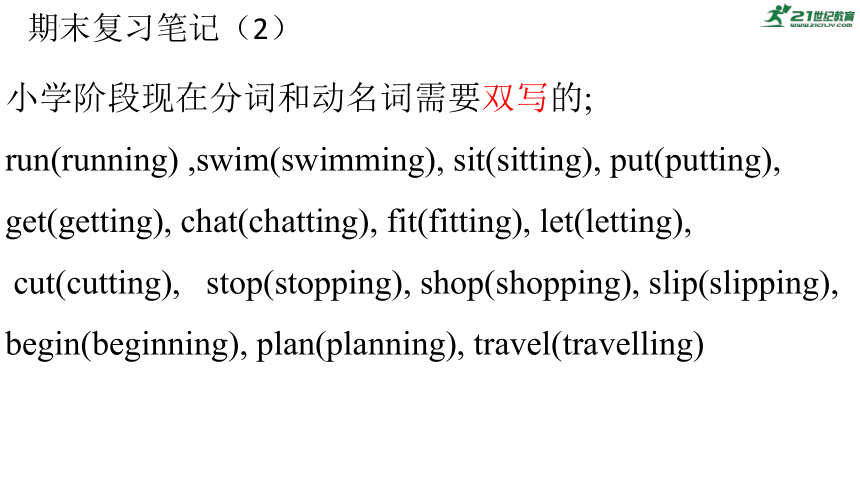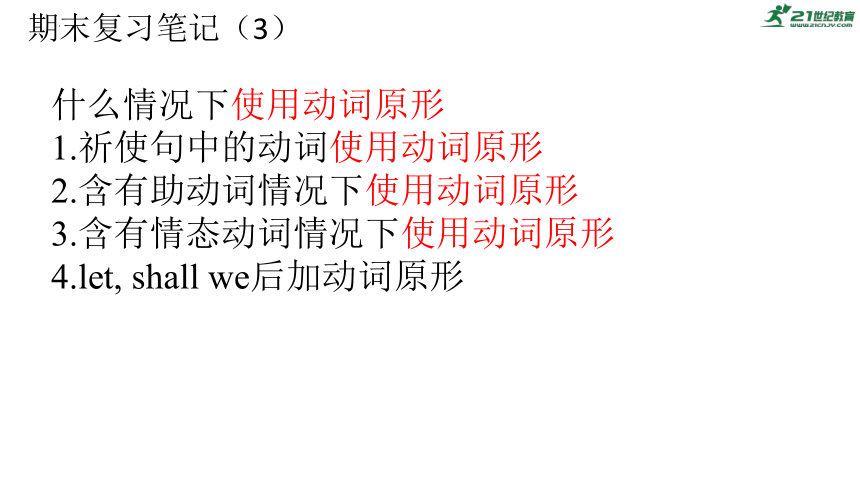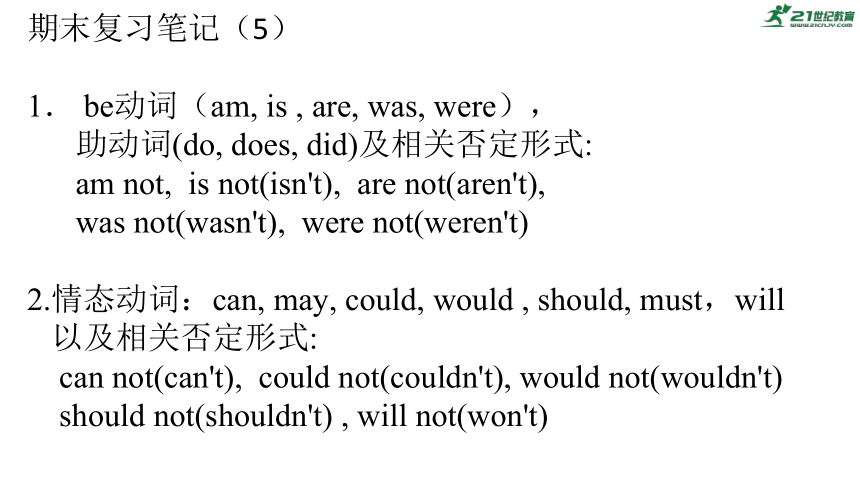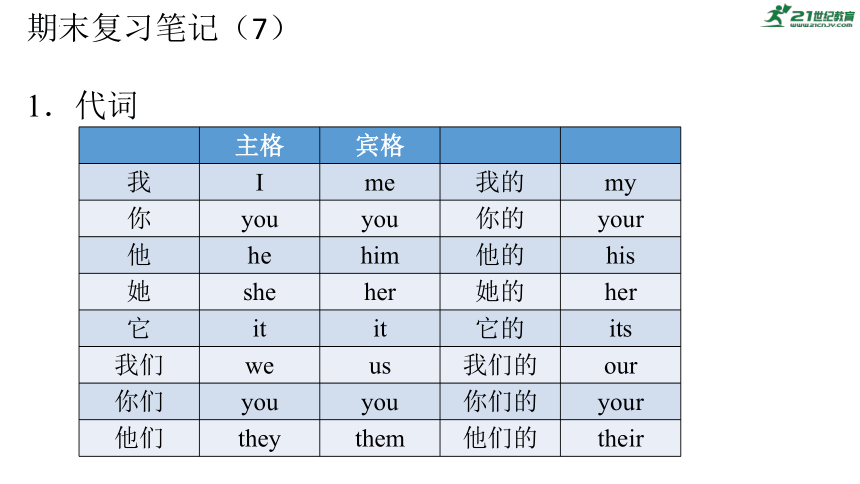译林版(三起)英语六年级上册期末重点知识点复习(课件)
文档属性
| 名称 | 译林版(三起)英语六年级上册期末重点知识点复习(课件) |  | |
| 格式 | pptx | ||
| 文件大小 | 157.8KB | ||
| 资源类型 | 试卷 | ||
| 版本资源 | 牛津译林版 | ||
| 科目 | 英语 | ||
| 更新时间 | 2023-12-27 13:44:38 | ||
图片预览







文档简介
(共17张PPT)
什么情况下动词+ing
1.like/love +动词ing
2.My hobby is +动词ing...
3.start /begin +动词ing
4.be good at +动词ing
5.What about +动词ing… / How about +动词ing…
6. go +动词ing
go climbing/swimming/boating
7.动词ing+school/lesson
a painting school a cooking school a swimming/dancing lesson…
8.do+动词ing
do some cleaning/ washing/shopping....
9.标志名称:No+动词ing
No eating or drinking. No smoking. No littering No parking
No fishing No swimming
期末复习笔记(1)
小学阶段现在分词和动名词需要双写的;
run(running) ,swim(swimming), sit(sitting), put(putting),
get(getting), chat(chatting), fit(fitting), let(letting),
cut(cutting), stop(stopping), shop(shopping), slip(slipping),
begin(beginning), plan(planning), travel(travelling)
期末复习笔记(2)
什么情况下使用动词原形
1.祈使句中的动词使用动词原形
2.含有助动词情况下使用动词原形
3.含有情态动词情况下使用动词原形
4.let, shall we后加动词原形
期末复习笔记(3)
什么情况下+to +动词原形
1.want to do, want to be,
2.would like to do,would like to be,
3.need to do,
4.What can we do to keep/ make…
5.be happy to do…
6.use…to do
7.reuse…to do
8. help…(to) do
9.how to do…
10. sorry to hear/.
11.It's time to...
12.wait to...
期末复习笔记(4)
期末复习笔记(5)
1. be动词(am, is , are, was, were),
助动词(do, does, did)及相关否定形式:
am not, is not(isn't), are not(aren't),
was not(wasn't), were not(weren't)
2.情态动词:can, may, could, would , should, must,will
以及相关否定形式:
can not(can't), could not(couldn't), would not(wouldn't)
should not(shouldn't) , will not(won't)
期末复习笔记(6)
3. 祈使句动词用原形
4. There be 结构(肯定、否定、疑问以及就近原则)
5. 动词或名词加后缀,变职业
加er: play—player dance---dancer
write----writer travel-traveller
teach---teacher drive---driver
farm---farmer work---worker
love-lover
加or visit---visitor
期末复习笔记(7)
1.代词
主格 宾格
我 I me 我的 my
你 you you 你的 your
他 he him 他的 his
她 she her 她的 her
它 it it 它的 its
我们 we us 我们的 our
你们 you you 你们的 your
他们 they them 他们的 their
期末复习笔记(8)
2.同义句:
It’s time to=It’s time for
come from=be from
go back=be back
show sth to sb.=show sb. Sth.
give sth. to sb.=give sb. Sth
标志中的同义句
on foot=walk to...
by bike= ride a bike to...
by car/bus/taxi/train/plane/minibus= take a....
I have...= There is/ are...
There isn't a=There is no...
There aren't any= There are no...
would like to do= want to do
What's the matter =What's wrong
期末复习笔记
1.各单元文化部分
(1)This is an American cowboy. He’s wearing jeans.
这是一位美国牛仔。他穿着牛仔服.
This is a Scottish man. He’s wearing a kilt.
这是一位苏格兰人。他穿着苏格兰短裙
(2)There are three main school holidays in the UK. They are the Easter holiday, the summer holiday and the Christmas holiday.
在英国有三个主要的学校假期。他们是复活节假期,暑假和圣诞假期。
(3)The Americans invented the airplane. 美国人发明飞机。
The British invented the train. 英国人发明火车。
期末复习笔记
(4)In the UK, people call the metro “underground”.
在英国,人们叫地铁“underground”。
In the US, people call the metro “subway”.
在美国,人们叫地铁“subway”。
(5)Earth Day is on 22nd April. 地球日在4月22日。
World Environment Day is on 5th June.世界环境日在6月5日。
We should love and protect our Earth.我们应该爱和保护我们的地球。
(6)Christmas is the most important holiday in the UK.
圣诞节是英国最重要的节日。
Chinese New Year is the most important festival in China.We also call it “Spring Festival”.
中国新年是中国最重要的节日。我们也叫它“春节”。
Thanksgiving is a very important holiday in the US.
感恩节是美国一个非常重要的节日。
期末复习笔记(语音)
ar [ a: ] arm card hard park
party Mark party farm
car bar Art farmer
garden March start star
supermarket
[ : ] warm quarter
期末复习笔记(语音)
ear [i ] dear hear near year
here
[ε ] pear there chair their
bear air wear where
careful care fairy square
er [ ] mother sister summer teacher
winter worker father mother
brother dinner tiger wonderful
sweater trousers Internet
[ : ] her shirt bird dirty
girl thirteen skirt birthday
thirsty first Thursday Saturday
hurt nurse turkey turn
work early
oo [ u: ] cool food room school
zoo classroom afternoon moon
noodles too tooth toothache
foolish
[ u ] book cook foot good
look good wood hooray
时态
1.一般现在时:表示事情或动作经常发生。
时态结构:
主语(第三人称单数)+动词(第三人称单数形式)
主语(非第三人称单数)+动词原形
2.现在进行时:表示事情或动作正在发生。
时态结构:
主语+be+动词ing
3.一般过去时:表示事情或动作已经发生。
时态结构:
主语+动词过去式
4.一般将来时:表示事情或动作将要发生。
时态结构:
主语+be going to(will)+动词原形
时态互换
1.找到动词原形。
2.根据要求改成相应时态的时态结构。
改一般疑问句
1.be动词
2.情态动词
3.行为动词
观察
1.be动词提前
2.情态动词提前
3.助动词提前
(原形do, 三单does,过去式(did)
动词恢复原形
*1.第一人称改成第二人称
I you we you
my your our your
什么情况下动词+ing
1.like/love +动词ing
2.My hobby is +动词ing...
3.start /begin +动词ing
4.be good at +动词ing
5.What about +动词ing… / How about +动词ing…
6. go +动词ing
go climbing/swimming/boating
7.动词ing+school/lesson
a painting school a cooking school a swimming/dancing lesson…
8.do+动词ing
do some cleaning/ washing/shopping....
9.标志名称:No+动词ing
No eating or drinking. No smoking. No littering No parking
No fishing No swimming
期末复习笔记(1)
小学阶段现在分词和动名词需要双写的;
run(running) ,swim(swimming), sit(sitting), put(putting),
get(getting), chat(chatting), fit(fitting), let(letting),
cut(cutting), stop(stopping), shop(shopping), slip(slipping),
begin(beginning), plan(planning), travel(travelling)
期末复习笔记(2)
什么情况下使用动词原形
1.祈使句中的动词使用动词原形
2.含有助动词情况下使用动词原形
3.含有情态动词情况下使用动词原形
4.let, shall we后加动词原形
期末复习笔记(3)
什么情况下+to +动词原形
1.want to do, want to be,
2.would like to do,would like to be,
3.need to do,
4.What can we do to keep/ make…
5.be happy to do…
6.use…to do
7.reuse…to do
8. help…(to) do
9.how to do…
10. sorry to hear/.
11.It's time to...
12.wait to...
期末复习笔记(4)
期末复习笔记(5)
1. be动词(am, is , are, was, were),
助动词(do, does, did)及相关否定形式:
am not, is not(isn't), are not(aren't),
was not(wasn't), were not(weren't)
2.情态动词:can, may, could, would , should, must,will
以及相关否定形式:
can not(can't), could not(couldn't), would not(wouldn't)
should not(shouldn't) , will not(won't)
期末复习笔记(6)
3. 祈使句动词用原形
4. There be 结构(肯定、否定、疑问以及就近原则)
5. 动词或名词加后缀,变职业
加er: play—player dance---dancer
write----writer travel-traveller
teach---teacher drive---driver
farm---farmer work---worker
love-lover
加or visit---visitor
期末复习笔记(7)
1.代词
主格 宾格
我 I me 我的 my
你 you you 你的 your
他 he him 他的 his
她 she her 她的 her
它 it it 它的 its
我们 we us 我们的 our
你们 you you 你们的 your
他们 they them 他们的 their
期末复习笔记(8)
2.同义句:
It’s time to=It’s time for
come from=be from
go back=be back
show sth to sb.=show sb. Sth.
give sth. to sb.=give sb. Sth
标志中的同义句
on foot=walk to...
by bike= ride a bike to...
by car/bus/taxi/train/plane/minibus= take a....
I have...= There is/ are...
There isn't a=There is no...
There aren't any= There are no...
would like to do= want to do
What's the matter =What's wrong
期末复习笔记
1.各单元文化部分
(1)This is an American cowboy. He’s wearing jeans.
这是一位美国牛仔。他穿着牛仔服.
This is a Scottish man. He’s wearing a kilt.
这是一位苏格兰人。他穿着苏格兰短裙
(2)There are three main school holidays in the UK. They are the Easter holiday, the summer holiday and the Christmas holiday.
在英国有三个主要的学校假期。他们是复活节假期,暑假和圣诞假期。
(3)The Americans invented the airplane. 美国人发明飞机。
The British invented the train. 英国人发明火车。
期末复习笔记
(4)In the UK, people call the metro “underground”.
在英国,人们叫地铁“underground”。
In the US, people call the metro “subway”.
在美国,人们叫地铁“subway”。
(5)Earth Day is on 22nd April. 地球日在4月22日。
World Environment Day is on 5th June.世界环境日在6月5日。
We should love and protect our Earth.我们应该爱和保护我们的地球。
(6)Christmas is the most important holiday in the UK.
圣诞节是英国最重要的节日。
Chinese New Year is the most important festival in China.We also call it “Spring Festival”.
中国新年是中国最重要的节日。我们也叫它“春节”。
Thanksgiving is a very important holiday in the US.
感恩节是美国一个非常重要的节日。
期末复习笔记(语音)
ar [ a: ] arm card hard park
party Mark party farm
car bar Art farmer
garden March start star
supermarket
[ : ] warm quarter
期末复习笔记(语音)
ear [i ] dear hear near year
here
[ε ] pear there chair their
bear air wear where
careful care fairy square
er [ ] mother sister summer teacher
winter worker father mother
brother dinner tiger wonderful
sweater trousers Internet
[ : ] her shirt bird dirty
girl thirteen skirt birthday
thirsty first Thursday Saturday
hurt nurse turkey turn
work early
oo [ u: ] cool food room school
zoo classroom afternoon moon
noodles too tooth toothache
foolish
[ u ] book cook foot good
look good wood hooray
时态
1.一般现在时:表示事情或动作经常发生。
时态结构:
主语(第三人称单数)+动词(第三人称单数形式)
主语(非第三人称单数)+动词原形
2.现在进行时:表示事情或动作正在发生。
时态结构:
主语+be+动词ing
3.一般过去时:表示事情或动作已经发生。
时态结构:
主语+动词过去式
4.一般将来时:表示事情或动作将要发生。
时态结构:
主语+be going to(will)+动词原形
时态互换
1.找到动词原形。
2.根据要求改成相应时态的时态结构。
改一般疑问句
1.be动词
2.情态动词
3.行为动词
观察
1.be动词提前
2.情态动词提前
3.助动词提前
(原形do, 三单does,过去式(did)
动词恢复原形
*1.第一人称改成第二人称
I you we you
my your our your
同课章节目录
